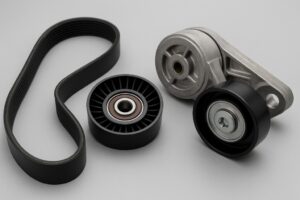Most car owners know when it’s time to replace a worn belt, but many overlook the pulleys and tensioners that keep it running smoothly. Skipping these components during belt replacement often leads to premature failure and repeated trips to the mechanic. Just like getting proper support for injuries caused by a rear-end accident, addressing the whole system prevents worse problems down the road.
Why Pulleys And Tensioners Wear Out
Pulleys contain internal bearings that spin thousands of times per minute while your engine runs. These bearings eventually dry out as grease breaks down, creating friction that damages the pulley from the inside. Heat, dust, and moisture accelerate this breakdown, especially in dusty environments or under extreme weather conditions.
Tensioners rely on spring mechanisms that weaken over time from constant pressure and temperature cycling. A weakened spring can’t maintain proper belt tension, causing the belt to slip on pulleys even when it’s brand new. The hydraulic tensioners found in some vehicles can develop leaks, reducing their ability to maintain consistent pressure.
Warning Signs That Pulleys Need Replacement
Squealing or chirping noises during engine startup often point to pulley problems rather than just belt wear. These sounds happen when bearings fail and the pulley can’t spin smoothly, causing the belt to slip and create friction. Grinding or rattling noises indicate that bearings have deteriorated to the point where metal grinds against metal.
Physical inspection reveals problems that aren’t always audible yet. Grab each pulley and try rocking it side to side. Any movement means worn bearings that need immediate replacement. Spin the pulleys by hand after removing the belt; if they rotate more than two full turns or feel rough and resistant, the bearings are shot.
Spotting Tensioner Failure
Visible belt slack indicates the tensioner spring has lost its strength and can’t maintain proper pressure anymore. You might spot glazing or unusual wear patterns on relatively new belts, which occur when inconsistent tension allows the belt to slip. Frayed edges or cracks in a recently installed belt almost always trace back to tensioner problems.
Multiple accessory failures co-occurring suggest tensioner issues affecting the entire belt system. Dimming headlights, combined with weak air conditioning and heavy steering, all point to a slipping belt caused by inadequate tension. Dashboard warning lights for the battery or charging system can result from tensioner failure rather than an actual electrical problem.
The Cost Of Skipping Component Replacement
Installing a new belt on worn pulleys can lead to premature belt failure, sometimes within just a few thousand miles. The old pulley bearings generate heat and friction, quickly chewing through fresh belt material. You’ll pay for another belt replacement much sooner than the typical 60,000 to 100,000-mile service interval.
A failed pulley or tensioner rarely breaks on its own. It usually takes the belt with it and sometimes damages other components. Picture your belt snapping on the highway because an old pulley seized up, leaving you without power steering, charging, or cooling. The tow bill and emergency repair costs dwarf what you’d have spent replacing everything during scheduled maintenance.
Smart Replacement Strategies
Replace pulleys and tensioners whenever you install a new timing belt or serpentine belt as standard practice. These components have similar lifespans, and doing everything together saves labor costs since the mechanic already has the system disassembled. Parts often come bundled in kits that include the belt, tensioner, and all pulleys at a better price than buying them separately.
High-mileage vehicles deserve extra attention to the entire belt system during inspection. Cars with more than 100,000 miles should have the pulleys checked for play, rough spinning, or noise, even if the belt looks decent. Replacing marginal components before they fail prevents breakdowns and protects other expensive parts from damage.
Making The Right Call
Mechanics can quickly assess the condition of pulleys and tensioners during belt service if you ask them to check. They’ll test for play, listen for bearing noise, and check tensioner spring strength as part of a thorough inspection. Getting this feedback helps you make smart decisions about which components need replacement now versus later.
Don’t wait for obvious failure symptoms, such as loud noises or visible damage, to replace these parts. Catching wear early through regular inspections keeps your vehicle reliable and prevents being stranded. The modest cost of preventive replacement beats the expense of emergency repairs and the hassle of unexpected breakdowns.
Conclusion
Treating belt service as a complete system repair rather than just swapping a single component prevents recurring failures and protects your investment. Pulleys and tensioners wear at roughly the same rate as belts, making simultaneous replacement the wise choice for long-term reliability. Just as getting proper support for injuries caused by a rear-end accident addresses the full scope of damage, replacing the entire belt system addresses the root cause rather than applying temporary fixes.
